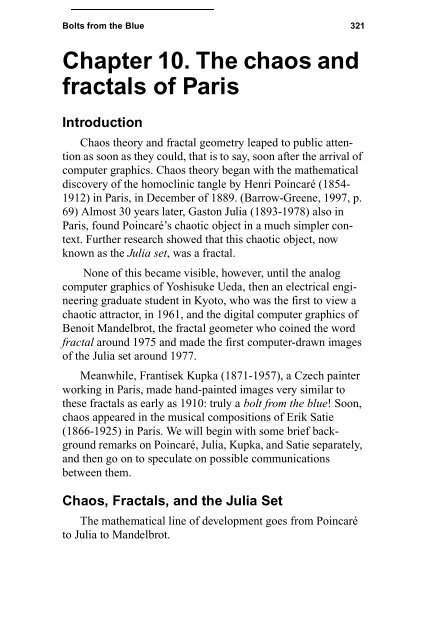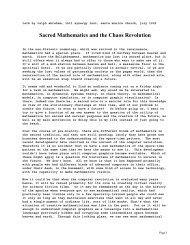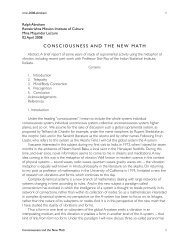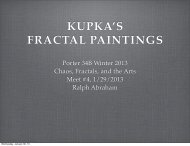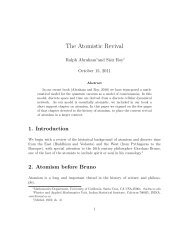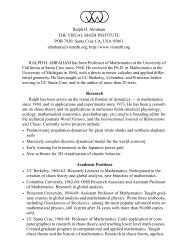Chapter 10. The chaos and fractals of Paris - Ralph Abraham
Chapter 10. The chaos and fractals of Paris - Ralph Abraham
Chapter 10. The chaos and fractals of Paris - Ralph Abraham
Create successful ePaper yourself
Turn your PDF publications into a flip-book with our unique Google optimized e-Paper software.
Bolts from the Blue 321<br />
<strong>Chapter</strong> <strong>10.</strong> <strong>The</strong> <strong>chaos</strong> <strong>and</strong><br />
<strong>fractals</strong> <strong>of</strong> <strong>Paris</strong><br />
Introduction<br />
Chaos theory <strong>and</strong> fractal geometry leaped to public attention<br />
as soon as they could, that is to say, soon after the arrival <strong>of</strong><br />
computer graphics. Chaos theory began with the mathematical<br />
discovery <strong>of</strong> the homoclinic tangle by Henri Poincaré (1854-<br />
1912) in <strong>Paris</strong>, in December <strong>of</strong> 1889. (Barrow-Greene, 1997, p.<br />
69) Almost 30 years later, Gaston Julia (1893-1978) also in<br />
<strong>Paris</strong>, found Poincaré’s chaotic object in a much simpler context.<br />
Further research showed that this chaotic object, now<br />
known as the Julia set, was a fractal.<br />
None <strong>of</strong> this became visible, however, until the analog<br />
computer graphics <strong>of</strong> Yoshisuke Ueda, then an electrical engineering<br />
graduate student in Kyoto, who was the first to view a<br />
chaotic attractor, in 1961, <strong>and</strong> the digital computer graphics <strong>of</strong><br />
Benoit M<strong>and</strong>elbrot, the fractal geometer who coined the word<br />
fractal around 1975 <strong>and</strong> made the first computer-drawn images<br />
<strong>of</strong> the Julia set around 1977.<br />
Meanwhile, Frantisek Kupka (1871-1957), a Czech painter<br />
working in <strong>Paris</strong>, made h<strong>and</strong>-painted images very similar to<br />
these <strong>fractals</strong> as early as 1910: truly a bolt from the blue! Soon,<br />
<strong>chaos</strong> appeared in the musical compositions <strong>of</strong> Erik Satie<br />
(1866-1925) in <strong>Paris</strong>. We will begin with some brief background<br />
remarks on Poincaré, Julia, Kupka, <strong>and</strong> Satie separately,<br />
<strong>and</strong> then go on to speculate on possible communications<br />
between them.<br />
Chaos, Fractals, <strong>and</strong> the Julia Set<br />
<strong>The</strong> mathematical line <strong>of</strong> development goes from Poincaré<br />
to Julia to M<strong>and</strong>elbrot.
322 Bolts from the Blue<br />
Poincaré<br />
Jules Henri Poincaré (1854 - 1912) earned the Ph.D. in mathematics<br />
from the Ecole Polytechnique in <strong>Paris</strong> in 1879. His talent was<br />
quickly manifest, <strong>and</strong> he became Pr<strong>of</strong>essor at the University <strong>of</strong> <strong>Paris</strong> in<br />
1881. He is now considered one <strong>of</strong> the great mathematicians <strong>of</strong> all time<br />
for his contributions in several traditional branches <strong>of</strong> mathematics, as<br />
well as his pioneering work in the creation <strong>of</strong> algebraic topology. Also<br />
to his credit is the discovery <strong>of</strong> chaotic dynamics in 1889, which cast<br />
<strong>of</strong>f the anchor <strong>of</strong> the deterministic paradigm <strong>of</strong> the sciences, initiating a<br />
paradigm shift which culminated only recently in <strong>chaos</strong> theory, a new<br />
branch <strong>of</strong> mathematics.<br />
Poincaré wrote over 500 papers, <strong>and</strong> several books, mostly highlevel<br />
works <strong>of</strong> technical mathematics. However, he also published<br />
many papers in popular journals, <strong>and</strong> four nontechnical books, before<br />
his premature death at the age <strong>of</strong> 58.<br />
<strong>The</strong> revolutionary artists <strong>of</strong> the modern art movement were greatly<br />
stimulated by the paradigm shifts <strong>of</strong> the sciences. Popular accounts by<br />
Bertr<strong>and</strong> Russell <strong>and</strong> Arthur Eddington were widely influential in<br />
Engl<strong>and</strong>. (Waddington, 1969, p. 100)<br />
Shortly afterward, the four popular books <strong>of</strong> Poincaré were widely<br />
read by artists <strong>and</strong> intellectuals in France, <strong>and</strong> had an effect on the<br />
development <strong>of</strong> the modern art movement in <strong>Paris</strong>. (Henderson, 1983,<br />
pp. 36, 97) (Shlain, 1991, pp. 195, 431) <strong>The</strong>se books are:<br />
• Science <strong>and</strong> Hypothesis (first Fr. ed., 1902),<br />
• <strong>The</strong> Value <strong>of</strong> Science (1904),<br />
• Science <strong>and</strong> Method (1908), <strong>and</strong><br />
• Last Thoughts (1913).<br />
English translations <strong>of</strong> the first three <strong>of</strong> these were republished in one<br />
volume, <strong>The</strong> Foundations <strong>of</strong> Science, in 1913. Among the influential<br />
ideas are: non-euclidean geometry, the fourth dimension, x-rays, spatial<br />
perception, chance <strong>and</strong> probability, etc.<br />
From our perspective today, we are particularly interested in<br />
Poincaré’s discovery in December <strong>of</strong> 1889 <strong>of</strong> the homoclinic tangle, the<br />
first example <strong>of</strong> a chaotic dynamical system. (Barrow-Greene, 1997,
Bolts from the Blue 323<br />
69) About this object, he wrote in Volume 3 <strong>of</strong> his technical<br />
text, Methodes Nouvelles <strong>of</strong> 1892:<br />
One must be struck by the complexity <strong>of</strong> this shape,<br />
which I do not even attempt to illustrate. Nothing can<br />
give us a better idea <strong>of</strong> the complication <strong>of</strong> the threebody<br />
problem, <strong>and</strong> in general <strong>of</strong> all problems <strong>of</strong> dynamics<br />
for which there is no uniform integral.<br />
(M<strong>and</strong>elbrot, 1983, p. 414)<br />
Figure 1. <strong>The</strong> homoclinic tangle <strong>of</strong> Poincaré. Drawing by Y.<br />
Ueda, from <strong>Abraham</strong> & Shaw, Part 2, p. 106.
324 Bolts from the Blue<br />
Note: This last condition is a generic property. That is, almost<br />
every problem <strong>of</strong> dynamics has this complexity: chaotic behavior.<br />
<strong>The</strong> first drawing <strong>of</strong> the homoclinic tangle was made by the<br />
mathematicians George Birkh<strong>of</strong>f <strong>and</strong> Paul Smith in the 1930s.<br />
<strong>The</strong> full significance <strong>of</strong> this discovery became widely<br />
appreciated only recently: Laplacian determinism is doomed.<br />
(Smale, 1980) But Poincaré certainly understood this. For in<br />
Science <strong>and</strong> Method (in <strong>Chapter</strong> 4 <strong>of</strong> Part I, titled “Chance”) he<br />
wrote:<br />
A very small cause that escapes our notice determines a<br />
considerable effect that we cannot fail to see, <strong>and</strong> then<br />
we say that the effect is due to chance. (Peterson, 1993,<br />
p. 167)<br />
In the wake <strong>of</strong> Poincaré’s discovery, <strong>chaos</strong> theory <strong>and</strong> fractal<br />
geometry gradually took shape. From all this history, we wish<br />
now to pull just one thread: the Julia set.<br />
Julia<br />
Paul Montel, pr<strong>of</strong>essor <strong>of</strong> mathematics in <strong>Paris</strong>, was a contemporary<br />
<strong>of</strong> Poincaré. Among his students was Gaston Julia<br />
(1893-1978). Julia took up a problem left behind by Poincaré’s<br />
death in 1912, <strong>and</strong> discovered the homoclinic tangle in a much<br />
simpler context (a quadratic map from the plane to itself) than<br />
that <strong>of</strong> Poincaré (the restricted three-body problem <strong>of</strong> celestial<br />
mechanics). Birkh<strong>of</strong>f in the US pursued a similar line <strong>of</strong><br />
research. In 1918, at age 25, Julia published a very long paper<br />
on his tangle, later known as the Julia set, which won him<br />
instant mathematical fame. His version <strong>of</strong> the complicated set,<br />
like Poincaré’s, was very difficult to visualize. In 1925, the slow<br />
process <strong>of</strong> visualization <strong>of</strong> the Julia set began, in a simple<br />
sketch by Cremer, a mathematician <strong>of</strong> Berlin. (Peitgen, Jurgens,<br />
<strong>and</strong> Saupe, 1992, pp. 138-139) This process languished until<br />
computer graphics came into the h<strong>and</strong>s <strong>of</strong> Benoit M<strong>and</strong>elbrot.
Bolts from the Blue 325<br />
M<strong>and</strong>elbrot<br />
Benoit M<strong>and</strong>elbrot (b. ca 1925) was a student at the University<br />
<strong>of</strong> <strong>Paris</strong>, <strong>and</strong> studied under Julia. Beginning around 1967,<br />
he formalized earlier work on strange sets, now known as <strong>fractals</strong>,<br />
<strong>and</strong> named <strong>and</strong> created fractal geometry. Around 1979,<br />
M<strong>and</strong>elbrot created very detailed images <strong>of</strong> the Julia set, for<br />
Figure 2. Julia set. From Devaney, 1992, Pl. 8.
326 Bolts from the Blue<br />
many different examples <strong>of</strong> the family <strong>of</strong> plane mappings set by<br />
Julia. He recognized it as a fractal, that is, as belonging to the<br />
small overlap <strong>of</strong> <strong>chaos</strong> theory <strong>and</strong> fractal geometry, two new<br />
branches <strong>of</strong> mathematics which owe much to computer graphics.<br />
<strong>The</strong>se fractal images from <strong>chaos</strong> theory are the best known<br />
<strong>fractals</strong>, although they represent only a very regular kind <strong>of</strong><br />
fractal. We can say that the Julia set came into popular consciousness<br />
after 1980. However, by 1910, it was already well<br />
known to one person, Frantisek Kupka.<br />
Kupka<br />
Frantisek Kupka (1871—1957) was born in Eastern Bohemia,<br />
the eldest <strong>of</strong> five children. He learned drawing from his<br />
father, but his early drawings were destroyed by his stepmother.<br />
By age 27, he was apprenticed to a saddler who also worked as<br />
a spiritualist. Kupka developed a talent for leading séances, <strong>and</strong><br />
supported himself as a medium after becoming a painter a few<br />
years later. He studied painting in Prague, Vienna, <strong>and</strong> <strong>Paris</strong>,<br />
<strong>and</strong> began exhibiting in these cities in 1899. Of note:<br />
• 1892, Kupka encountered theosophy, became vegetarian.<br />
• 1895, Kupka read extensively in philosophy, including<br />
Kant, Shopenhauer, Bergson, <strong>and</strong> Nietzsche.<br />
• 1905, Kupka exhibition a great success. He began attending<br />
lectures in physics, biology, <strong>and</strong> physiology at the<br />
Sorbonne, <strong>and</strong> worked in the biology laboratory there.<br />
• 1910, Kupka destroyed most <strong>of</strong> his paintings, <strong>and</strong> began a<br />
new phase. This is the year <strong>of</strong> Kupka’s first abstract paintings,<br />
including the Amorpha series.<br />
• 1911, Kupka attended meetings with a group <strong>of</strong> artists<br />
<strong>and</strong> writers every Sunday morning at the home <strong>of</strong> his<br />
neighbor, Jacques Villon.<br />
• 1912, Kupka continues to attend the meetings. A mathematician,<br />
Maurice Princet, also attended. Kupka’s first<br />
abstract paintings were exhibited in <strong>Paris</strong>.
Bolts from the Blue 327<br />
We now see the first precognition <strong>of</strong> fractal <strong>and</strong> chaotic<br />
images in the Amorpha series <strong>of</strong> 1910 - 1912. (Andel, 1977, p.<br />
85) (Waddington, 1970, p. 22)<br />
Satie<br />
Erik Satie was on the forefront <strong>of</strong> musical performance at<br />
the time <strong>of</strong> Poincaré’s discovery <strong>of</strong> chaotic dynamics. He was<br />
involved with Sar Péledan, the high-priest <strong>of</strong> the Rosecrucian<br />
<strong>and</strong> Chaldean confraternity, <strong>and</strong> composed for it, in 1890. By<br />
1900, he was incorporating American Ragtime styles in his<br />
Figure 3. Kupka, Amorpha, Fugue in two colors, 1912, #68<br />
from the DMA catalog. (Andel, 1996, p. 129)
328 Bolts from the Blue<br />
compositions, an early form <strong>of</strong> Jazz. He was an eccentric composer<br />
in <strong>Paris</strong> by 1905.<br />
He meet Jean Cocteau (1891-1963) — French poet, dramatist,<br />
<strong>and</strong> leader <strong>of</strong> the literary avant-garde — in 1915. Serge de<br />
Diaghilev (1872-1929) directed a Russian ballet company<br />
which was popular in Europe before the First World War. Cocteau<br />
was a close friend <strong>of</strong> Diaghilev. In 1915, Cocteau was commissioned<br />
by Diaghilev, then in Rome, to write a ballet. <strong>The</strong><br />
idea for the ballet came to him in April <strong>of</strong> 1915, during a holiday<br />
from the front, after hearing a piano duet by Satie <strong>and</strong><br />
Ricardo Viñes. Cocteau enlisted Léonide Massine, the most daring<br />
<strong>of</strong> choreographers, Pablo Picasso, <strong>and</strong> Satie to work as a<br />
team on this project. Work began in the Spring <strong>of</strong> 1915, the scenario<br />
by Cocteau, choreography by Massine, <strong>and</strong> sets <strong>and</strong> costumes<br />
by Picasso, were created in Rome, while Satie began<br />
working in the spring <strong>of</strong> 1916 on the music at a cafe in <strong>Paris</strong>.<br />
<strong>The</strong> result, the realist ballet Parade, was produced at the<br />
Théatre du Châtelet in <strong>Paris</strong> on May 18, 1917, just as the Dada<br />
movement was getting underway. Revolutionary <strong>and</strong> shocking,<br />
it manifest Cubism in music, choreography, sets, <strong>and</strong> costumes.<br />
<strong>The</strong> audience rioted. Critics called the musical score — it called<br />
for revolvers, sirens, clappers, typewrites, lottery-wheels, Morse<br />
code keys, <strong>and</strong> so on — a 'mere din'. Progressing from order (an<br />
introductory fugue) to syncopation (inspired by Ragtime) to<br />
<strong>chaos</strong> (a frenzied dance finale), the musical score now suggests<br />
the bifurcation diagram <strong>of</strong> the logistic function basic to <strong>chaos</strong><br />
theory, <strong>and</strong> the <strong>fractals</strong> <strong>of</strong> Julia <strong>and</strong> Fatou as first shown in computer<br />
graphics by M<strong>and</strong>elbrot. Appolonaire's review <strong>of</strong> the ballet<br />
coined the word surrealism to describe the revolutionary<br />
ballet.<br />
<strong>The</strong> team worked together again to produce the ballet Mercure,<br />
first preformed in <strong>Paris</strong> in 1924, after the Dada movement<br />
had been replaced by Surrealism. This ballet included twelve<br />
principal scenes, one <strong>of</strong> which is actually called Chaos. Satie's<br />
score for this scene combined the themes <strong>of</strong> two earlier (<strong>and</strong><br />
very disparate) scenes to suggest <strong>chaos</strong>, which is surprisingly
Bolts from the Blue 329<br />
similar to the discovery <strong>of</strong> chaotic behavior in electronic circuits<br />
by Van der Pol, working in Holl<strong>and</strong> at about this same<br />
time, with the coupling <strong>of</strong> two electronic oscillators. (Templier,<br />
pp. 36-41; Harding, p. 155; Myers, pp. 49, 102-105)<br />
Conclusion<br />
We may now sit back <strong>and</strong> compare the homoclinic tangle,<br />
Figure 1 <strong>of</strong> 1936, the Julia set <strong>of</strong> M<strong>and</strong>elbrot, Figure 3 <strong>of</strong> 1979,<br />
the Amorpha painting <strong>of</strong> Kupka, Figure 4, <strong>of</strong> 1912, <strong>and</strong> the<br />
score <strong>of</strong> Satie <strong>of</strong> 1916. Many more such comparisons could be<br />
made.<br />
Setting aside paranormal explanations, séances, <strong>and</strong> the<br />
like, we may grasp at straws in seeking connections from the<br />
Poincaré line to Kupka <strong>and</strong> Satie. All we have found are:<br />
• Poincaré’s first two popular books appeared in the original<br />
French editions in 1902 <strong>and</strong> 1904, <strong>and</strong> were extensively<br />
read by <strong>Paris</strong>ian intellectuals, including the painter<br />
Duchamps.<br />
• Kupka spent most <strong>of</strong> 1905 reading philosophy books, <strong>and</strong><br />
attending lectures <strong>and</strong> working at the Sorbonne, where<br />
Poincaré was then lecturing.<br />
• Cocteau <strong>and</strong> Satie were intimate with the literary <strong>and</strong><br />
artistic elite <strong>of</strong> <strong>Paris</strong> from 1905.<br />
Connections tenuous at best. Truly a bolt from the blue!<br />
Bibliography<br />
Ainsley, Robert, ed., <strong>The</strong> Encyclopedia <strong>of</strong> Classical Music.<br />
London: Carlton Books, 1999.<br />
Andel, Jaroslav, <strong>and</strong> Dorothy Kosinski, eds., Painting the Universe:<br />
Frantisek Kupka, Pioneer in Abstraction, Dallas: Dallas<br />
Museum <strong>of</strong> Art, 1997.<br />
Fleming, William, Arts <strong>and</strong> Ideas, 6th ed. New York: Holt,<br />
Rinehart <strong>and</strong> Winston, 1955/1980.
330 Bolts from the Blue<br />
Gillispie, Charles, Dictionary <strong>of</strong> Scientific Biography. Poincaré<br />
entry.<br />
Harding, James, Erik Satie. London: Secker <strong>and</strong> Warburg, 1975.<br />
Henderson, Linda Dalrymple, X Rays <strong>and</strong> the quest for invisible<br />
reality in the art <strong>of</strong> Kupka, Duchamp, <strong>and</strong> the Cubists, Art<br />
Journal, Winter 1988, pp. 323-340.<br />
Henderson, Linda Dalrymple, <strong>The</strong> Fourth Dimension <strong>and</strong> Non-<br />
Euclidean Geometry in Modern Art, Princeton: Princeton University<br />
Press, 1983.<br />
Henderson, Linda Dalrymple, Duchamp in Context: Science<br />
<strong>and</strong> Technology in the “Large Glass” <strong>and</strong> Related Works, Princeton:<br />
Princeton University Press, 1998.<br />
M<strong>and</strong>elbrot, Benoit B., Fractals: Form, Chance, <strong>and</strong> Dimension.<br />
San Francisco: W. H. Freeman, 1977.<br />
M<strong>and</strong>elbrot, Benoit B., <strong>The</strong> Fractal Geometry <strong>of</strong> Nature. San<br />
Francisco: W.H. Freeman, 1982.<br />
Myers, Rollo H., Erik Satie. St. Clair Shores, Michigan: Scholarly<br />
Press, 1947/1977.<br />
Shlain, Leonard, Art <strong>and</strong> Physics: Parallel Visions in Space,<br />
Time, <strong>and</strong> Light. New York: Morrow, 1991.<br />
Smale, Stephen, <strong>The</strong> mathematics <strong>of</strong> time: essays on dynamical<br />
systems, economic processes, <strong>and</strong> related topics. New York:<br />
Springer-Verlag, 1980.<br />
Templier, Pierre-Daniel, Erik Satie. Cambridge, MA.: MIT<br />
Press, 1969.<br />
Waddington, Conrad, Behind Appearance: A study <strong>of</strong> the relations<br />
between painting <strong>and</strong> the natural sciences in this century.<br />
Edinburgh: Edinburgh University Press, 1969. Cambridge, MA:<br />
MIT Press, 1970.


